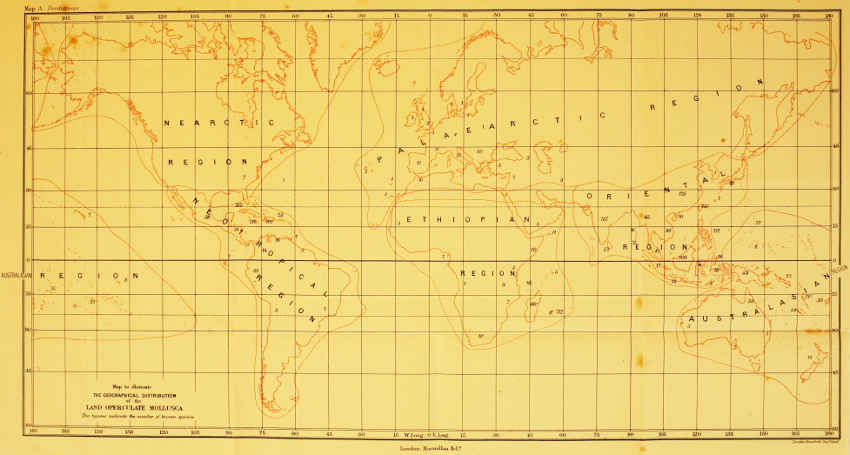Transcriber’s Note:
This work features some large and wide tables. These are best viewedwith a wide screen.
THE
CAMBRIDGE NATURAL HISTORY
EDITED BY
S. F. HARMER, M.A., Fellow of King’s College, Cambridge; Superintendent
of the University Museum of Zoology
AND
A. E. SHIPLEY, M.A., Fellow of Christ’s College, Cambridge;
University Lecturer on the Morphology of Invertebrates
VOLUME III


Map to illustrate
THE GEOGRAPHICAL DISTRIBUTION
of the
LAND OPERCULATE MOLLUSCA
The figures indicate the number of known species.
MOLLUSCS
By the Rev. A. H. Cooke, M.A., Fellow and Tutor ofKing’s College, Cambridge
BRACHIOPODS (RECENT)
By A. E. Shipley, M.A., Fellow of Christ’s College,Cambridge
BRACHIOPODS (FOSSIL)
By F. R. C. Reed, M.A., Trinity College, Cambridge
New York
MACMILLAN AND CO.
AND LONDON
1895
All rights reserved
“Why, you might take to some light study: conchology, now; Ialways think that must be a light study.”
George Eliot, Middlemarch.
Copyright, 1895,
By MACMILLAN AND CO.
Norwood Press:
J. S. Cushing & Co.—Berwick & Smith.
Norwood, Mass., U.S.A.
[v]
PREFACE TO THE MOLLUSCA
The general plan of classification adopted in this work is not that ofany single authority. It has been thought better to adopt the views ofrecognised leading specialists in the various groups, and thus placebefore the reader the combined results of recent investigation. Thismethod may, perhaps, occasion a certain number of small discrepancies,but it is believed that the ultimate effect will be to the advantage ofthe student.
The classification adopted for the recent Cephalopoda is that of Hoyle(‘Challenger’ Reports, Zoology, vol. xvi.), for the fossilCephalopoda (Nautiloidea) that of Foord (Catalogue of the FossilCephalopoda in the British Museum, 1888–91), and (Ammonoidea) P.Fischer (Manuel de Conchyliologie, 1887). In the Gasteropodathe outlines are those adopted by Pelseneer (Mém. Soc. Malacol.Belg. xxvii. 1894), while the details are derived, in the main,from P. Fischer. The Amphineura, however, have not been regardedas a separate class. The grouping of the Nudibranchiata is that ofBergh (Semper, Reisen im Archipel der Philippinen, ii. 3). ThePelecypoda are classified according to Pelseneer’s most recent grouping.
Acknowledgment of the principal sources of